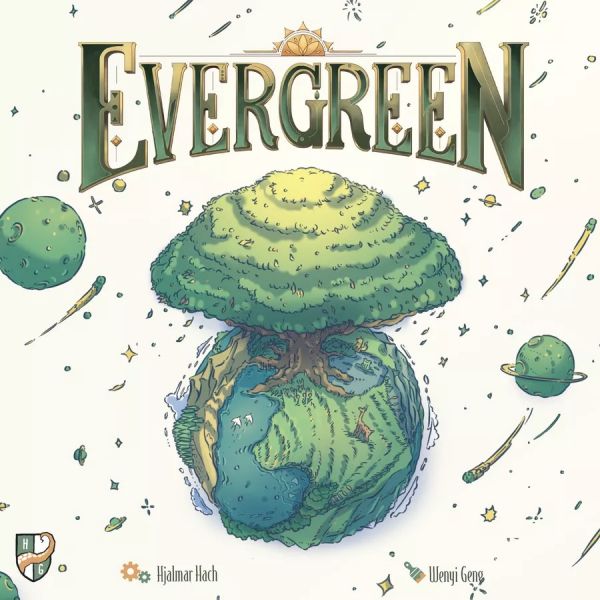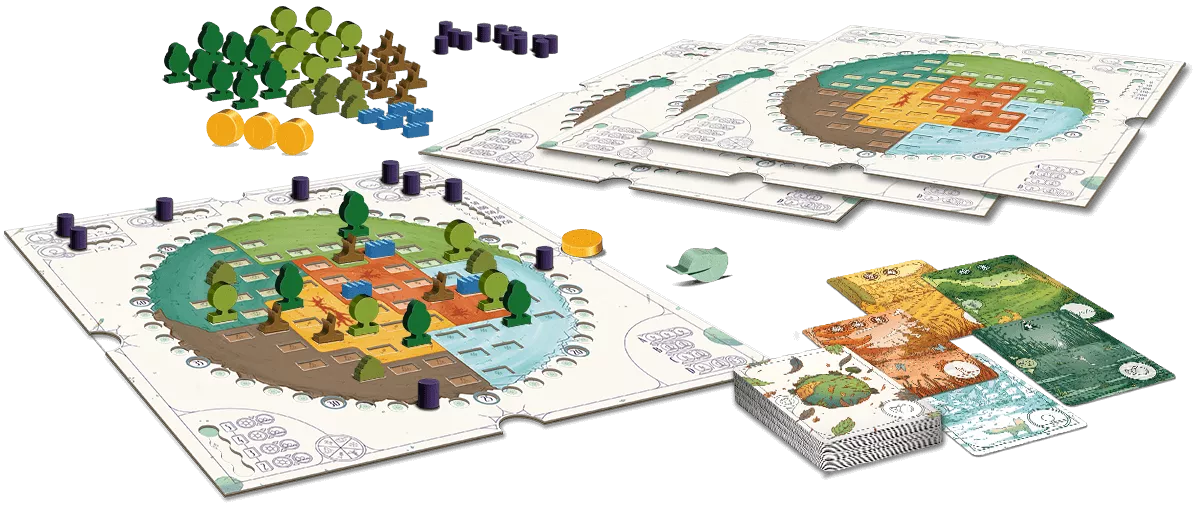Plant Trees and Cultivate Thriving Forests in Evergreen

Evergreen is a 1-4 player abstract puzzle game from renowned designer Hjalmar Hach, with gorgeous art design from Wenyi Geng.
Gameplay
Evergreen is a game in which players are taking actions to plant and grow trees across a multitude of ecosystems, in an effort to create a giant forest while also accounting for which direction the sun shines during the game’s four rounds to maximize points for mature trees.
Much of Evergreen boils down to the cards and their interactions with each player’s boards, where everyone is creating forests across their own planet’s surface. The players will select cards for a pool determined by the player count (for example, a 3-player game will have 4 cards in the pool). Each card will represent one of the six biomes available to place a tree, both presented by unique shades as well as the matching symbol on the left-center side of the card. The lower right side of the card shows the available power players may be able to use this round. The top of the card determines the card’s fertility or aridity.
Beginning with the left-center, players can perform one of four actions that are shown on the lower right of their player board: planting three tree sprouts matching the biome on the card, growing two separate trees matching the card’s biome, planting one sprout and also growing a separate tree from the one just planted, or ignoring the card’s biome to plant one sprout or perform a growth to any one tree in any biome.
Powers are just as important, and the symbol on the lower-right of the card can provide two options when a card is selected: it can raise the threshold of that power’s abilities by allowing players to move the track marker for the corresponding power on their individual player tracks on their boards, or they may perform that power, placing as many of that power’s parts on their board as indicated by the marker’s position on its corresponding tracker. The 6 powers available are planting sprouts, replacing sprouts with small trees equal to the marker’s position, replacing small trees with big trees equal to the market’s position, planting bushes (which can help connect trees into a forest), placing lakes (which allows any orthogonal trees to grow once), or scoring immediate points for the marker’s location on the Bud tracker. Powers that allow for the placement of trees, bushes, and lakes, or growing trees are not restricted by the biome of the card a player chose.
After a player chooses a card from the drafting pool, they can choose to do the action and power in any order. When the first player takes a card, they must place the first player marker on the leftmost card remaining in the drafting pool. Whoever claims that card becomes the first player during the next turn. Play continues until all but one of the biome cards has been selected. The remaining card is moved to the side and becomes an end of game scoring card, where each big tree within that biome will score depending on the total fertility of all the cards of that biome left over by game’s end.
Each of the four rounds has a different number of turns, indicated by the marker on the lower left of each player’s boards (for example, the first round will have 5 turns, the second round will have 4 turns, etc.). Once all the turns in a round have concluded, scoring for the round (end of season) will commence. Points are determined by the positioning of the sun (in round one, it will reside on the north of each person’s board, in the second round it will reside on the east, etc.). Small trees are each worth one point and big trees are each worth two points, so long as trees of equal or greater size are not within their shadow. For example, if two small trees are in a row during a scoring phase, the first small tree (closet to the sun) will gain a point, but the second — being in the one space shadow behind the small tree in front of it — will not score a point. Big trees have a shadow of two spaces, so any trees within that two-space shadow will not score. Players will also determine the size of their biggest forest, which includes small and big trees, as well as bushes, that are orthogonally adjacent.
Points are tallied and players will move their scoring markers to the appropriate point total around their planets on the player boards, the sun moves clockwise on everyone’s board, and then the next round begins. Play continues like this until all four rounds have finished.
After scoring the end of season for the last time, players will have one more scoring based on the cards left over from each season. Scores are determined by the total number of fertility for each represented biome card. For example, the Rock biome may have three unselected cards at the end of the game for scoring: one with two fertility symbols, one with one fertility symbol, and one with one aridity symbol. The total will be determined by adding up the fertility symbols and subtracting the number of aridity symbols, so in the example the Rock biome would net players 2 points per big tree in the Rock biome. This works across all 6 biomes (some biomes may have no cards left over at game’s end, or the aridity may reduce the fertility total to 0 points). Once players count up fertility points and add them to their total, the player with the most points is declared the winner. In case of a tie, the player who comes first in turn order is the winner.

Review
Though it may seem complicated at first, Evergreen is a relatively easy game to pick up and play. The rules, despite having a bit of overhead, are simply and smartly laid out in the game’s rulebook. It’s easy to follow, there are pictures galore, and the symbology on both the biome cards and the player boards makes it easy to understand what to do after a couple of turns. And games are so quick, that when new players finally realize how Evergreen’s puzzle unfolds, they’ll want to play another with the new knowledge they’ve gained.
And this is not just the experience of new players. As the game becomes more familiar, even seasoned players will want to experiment with different strategies and gaming styles. Coupled with the drafting mechanism, it’ll take multiple games for people to come to any conclusion about these strategies because where they can place and grow trees, as well as end of game scoring, will often be different.
It’s this mix of direct interaction during drafting, coupled with the individuality of actions and powers on each player’s own boards, where Evergreen separates itself from Hach’s own Photosynthesis, which Evergreen was initially compared to. However, Evergreen is a far more streamlined game, both in terms of available actions and the correlations within.
As board gaming continues to evolve and grow, abstract puzzle games that are tests of player’s spatial abilities can often come with frustration. Evergreen may have a few players steaming, either due to another player drafting the biome card they were eyeing or trying to figure out how best to min-max their end of season scores with an eye toward end of game scoring. Yet, the ability to pivot mid-turn is available thanks to the use of powers.
Evergreen is an evolving game all on its own, despite being a simple game once players understand the basic strategy. And as much consternation as puzzle games may be to some, others will find it the perfect game to unwind with, either in a group or solo. It doesn’t hurt that Wenyi Geng’s artwork is eye-catching and relaxing all on its own.
Pros: Puzzle game that can be as competitive or as relaxing as players wish, multiple strategies with multiple paths to success, eye-catching artwork
Cons: Scoring rules may take a moment to learn







